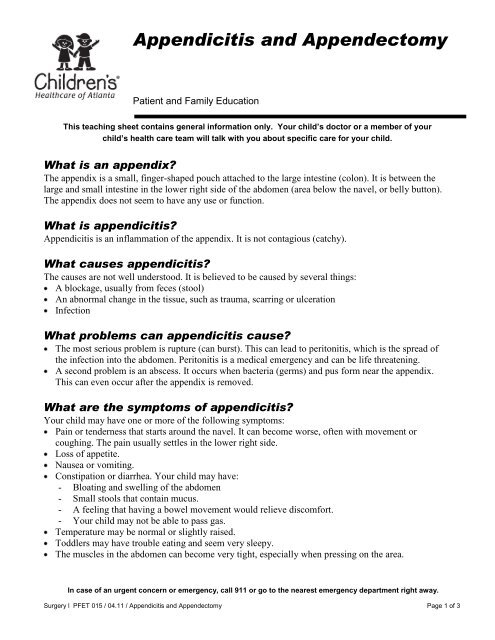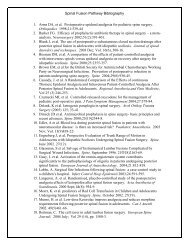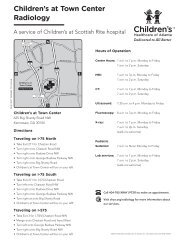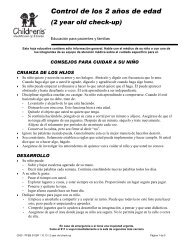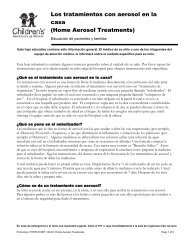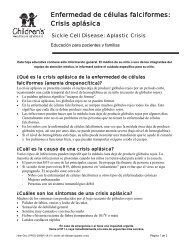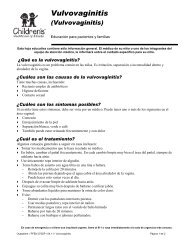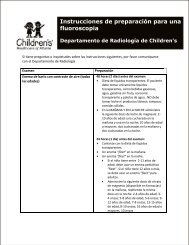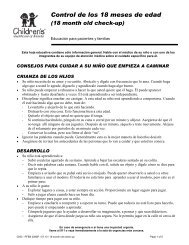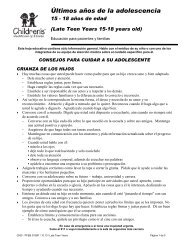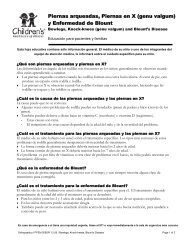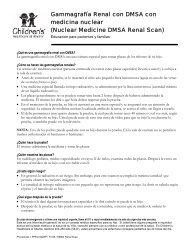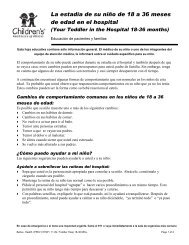Appendicitis and Appendectomy
Appendicitis and Appendectomy
Appendicitis and Appendectomy
Create successful ePaper yourself
Turn your PDF publications into a flip-book with our unique Google optimized e-Paper software.
<strong>Appendicitis</strong> <strong>and</strong> <strong>Appendectomy</strong><br />
Patient <strong>and</strong> Family Education<br />
This teaching sheet contains general information only. Your child’s doctor or a member of your<br />
child’s health care team will talk with you about specific care for your child.<br />
What is an appendix?<br />
The appendix is a small, finger-shaped pouch attached to the large intestine (colon). It is between the<br />
large <strong>and</strong> small intestine in the lower right side of the abdomen (area below the navel, or belly button).<br />
The appendix does not seem to have any use or function.<br />
What is appendicitis?<br />
<strong>Appendicitis</strong> is an inflammation of the appendix. It is not contagious (catchy).<br />
What causes appendicitis?<br />
The causes are not well understood. It is believed to be caused by several things:<br />
A blockage, usually from feces (stool)<br />
An abnormal change in the tissue, such as trauma, scarring or ulceration<br />
Infection<br />
What problems can appendicitis cause?<br />
The most serious problem is rupture (can burst). This can lead to peritonitis, which is the spread of<br />
the infection into the abdomen. Peritonitis is a medical emergency <strong>and</strong> can be life threatening.<br />
A second problem is an abscess. It occurs when bacteria (germs) <strong>and</strong> pus form near the appendix.<br />
This can even occur after the appendix is removed.<br />
What are the symptoms of appendicitis?<br />
Your child may have one or more of the following symptoms:<br />
Pain or tenderness that starts around the navel. It can become worse, often with movement or<br />
coughing. The pain usually settles in the lower right side.<br />
Loss of appetite.<br />
Nausea or vomiting.<br />
Constipation or diarrhea. Your child may have:<br />
- Bloating <strong>and</strong> swelling of the abdomen<br />
- Small stools that contain mucus.<br />
- A feeling that having a bowel movement would relieve discomfort.<br />
- Your child may not be able to pass gas.<br />
Temperature may be normal or slightly raised.<br />
Toddlers may have trouble eating <strong>and</strong> seem very sleepy.<br />
The muscles in the abdomen can become very tight, especially when pressing on the area.<br />
In case of an urgent concern or emergency, call 911 or go to the nearest emergency department right away.<br />
Surgery l PFET 015 / 04.11 / <strong>Appendicitis</strong> <strong>and</strong> <strong>Appendectomy</strong> Page 1 of 3
<strong>Appendicitis</strong> <strong>and</strong> <strong>Appendectomy</strong>, continued<br />
What medical tests may my child have?<br />
Some tests that might be helpful to your child’s doctor include:<br />
Blood tests - blood tests alone cannot confirm appendicitis, but an increase in the WBC (white blood<br />
cell) count may point to it.<br />
A routine urine test<br />
X-Ray, ultrasound exam or CT scan of the abdomen may help to show an inflamed appendix.<br />
What is the treatment for appendicitis?<br />
There is no known medical treatment for appendicitis – surgery is needed. Your child’s doctor will talk<br />
with you about specific care for your child. Some general guidelines to follow include:<br />
An appendectomy is an operation to remove the appendix. It can be done in two different ways,<br />
depending on your child’s condition:<br />
- Laparoscopy – this is a type of surgery where 3 or 4 small incisions are made in the abdomen to<br />
remove the appendix. A lighted tube with a camera on the end (called a laparoscope) is used to<br />
check the area. Special instruments are used to remove the appendix. Your child can usually go<br />
home within a day after this type of surgery.<br />
- Open incision - a larger incision is made on the lower, right side of the abdomen. If an abscess<br />
or peritonitis has occurred, the area is “washed” well after the appendix is removed. Your child<br />
can usually go home within a day or two after this type of surgery.<br />
Surgery is done using general anesthesia, so your child will be in a deep sleep. He will not feel pain<br />
during the surgery.<br />
Other treatments may include:<br />
- Antibiotics (medicines to kill germs).<br />
- Intravenous (IV or in the vein) fluids.<br />
- Drain tubes left in place after surgery to drain fluids from the abdomen.<br />
- Medicines for pain.<br />
- Getting out of bed as soon as he is able. Walking helps the lungs stay clear <strong>and</strong> helps get rid of<br />
excess gas in the abdomen.<br />
What is the treatment for a ruptured appendix?<br />
A ruptured appendix usually requires more treatment.<br />
Antibiotics may be needed for a longer time.<br />
Your child may also need a nasogastric (NG) tube connected to suction. An NG tube is a long, soft,<br />
flexible tube placed in the nose, down the throat <strong>and</strong> into the stomach. It is usually kept in place for<br />
several days until normal bowel function returns.<br />
What is the treatment for an abscess?<br />
Sometimes patients are sent home on antibiotics to clear up the infection before surgery is done. A<br />
drainage tube may be left in place during this time.<br />
When can my child return to daycare, school or work?<br />
Your child’s doctor will tell you when your child can return to normal activities. Your child may need<br />
to:<br />
Rest at home for a week or two.<br />
Refrain from strenuous activities such as gym class, sports or heavy lifting for about a month.<br />
In case of an urgent concern or emergency, call 911 or go to the nearest emergency department right away.<br />
Surgery l PFET 015 / 04.11 / <strong>Appendicitis</strong> <strong>and</strong> <strong>Appendectomy</strong> Page 2 of 3
<strong>Appendicitis</strong> <strong>and</strong> <strong>Appendectomy</strong>, continued<br />
When should I call the doctor?<br />
Call your child’s doctor right away if your child has any of the following:<br />
Fever over 101 0 F<br />
Signs of infection in the incision area such as:<br />
- Redness<br />
- Swelling<br />
- Increased drainage or bleeding<br />
- Increased pain<br />
Also call your child’s doctor for:<br />
Pain not relieved by his pain medicine<br />
Any questions or concerns you have about how your child looks or feels.<br />
In case of an urgent concern or emergency, call 911 or go to the nearest emergency department right away.<br />
Surgery l PFET 015 / 04.11 / <strong>Appendicitis</strong> <strong>and</strong> <strong>Appendectomy</strong> Page 3 of 3


